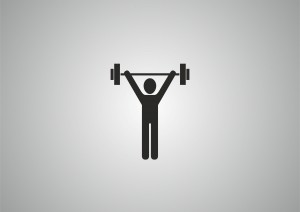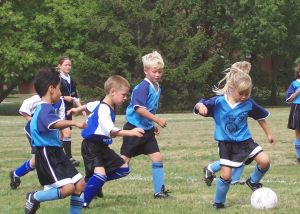By Jeff King, MA, CSCS
My name is Jeff King and I am the Director of Athletics at Fitness Quest 10 in San Diego. Over the past nine years, I have had the great opportunity to work with young athletes. Thousands of hours training kids have created many positive memories and allowed me to make a positive impact on the youth of America. Above all, the experiences of being around kids and seeing other coaches training kids, and reading literature on young athletes has allowed me to get a better understanding of the science of training and coaching kids. In this 3-part series, I will examine how one should approach training kids for sports.
The base of any youth training program should be developing a strong foundation. To examine how important this is, let’s take a look at professional sports. Any pro team that is fortunate enough to win a championship has a few things in common. One, they have talented players. Two, and more importantly, they all preached and executed the basic fundamentals of their sport. Coaches always say doing the fundamentals consistently will lead to success. This holds true in many aspects of life including developing athleticism in young athletes.
 Coaches often times try to reinvent the wheel and come up with cutting-edge, innovative training protocols. At the end of the day, getting kids to become masters of basic human movement will lead to improved athleticism and on court/field performance. The necessity and urgency for coaches to incorporate fundamental movement patterns into their training regimen was non-existent a generation ago.
Coaches often times try to reinvent the wheel and come up with cutting-edge, innovative training protocols. At the end of the day, getting kids to become masters of basic human movement will lead to improved athleticism and on court/field performance. The necessity and urgency for coaches to incorporate fundamental movement patterns into their training regimen was non-existent a generation ago.
When I was kid, my days during the summer consisted of playing various games outside until the streetlights came on (if you don’t know what I am talking about then you are definitely younger than me!). The beauty about this playtime was that it was unstructured and unsupervised. This allowed the kids to be very creative in the types of games they decided to play.
The games we played involved crawling, climbing, squatting, sprinting, pulling and problem solving. All these movements are primitive movement patterns. What does this mean? Well, I was never taught how to crawl, climb, squat and sprint during game play. I just naturally did it because the human body is wired to execute these movements instinctively. Just look at babies. They learn how to crawl, squat and walk with no verbal cuing from anyone.
The human brain is made to solve problems. Putting kids in a complex environment is the best thing for them as they are forced to solve problems. (I.e. how do I jump over this log). Playing sports is nothing more than solving complex motor tasks throughout a given game or match.
The millennium has ushered in a generation of kids who do not participate in free and unorganized play. Instead, they are either playing video games or practicing sports year round (early-sports specialization). This lack of play has led kids to be underexposed to fundamental movement patterns and under prepared to participate in junior high and high school training programs because of their lack of ability to squat, hip hinge and move their own body weight fluidly. Therefore, the current strength coach has a responsibility to expose their kids to these fundamental movement patterns.
 I like to refer to these movements as the ABC’s of athleticism. A child cannot learn to write and put sentences together without knowing their alphabet. You can apply this same thought process to youth training. It’s unfair and wrong to ask an athlete to complete a complex movement such as a power clean if they cannot squat properly. Getting a young child to crawl, skip, jump, and squat properly is the foundation of athletic success.
I like to refer to these movements as the ABC’s of athleticism. A child cannot learn to write and put sentences together without knowing their alphabet. You can apply this same thought process to youth training. It’s unfair and wrong to ask an athlete to complete a complex movement such as a power clean if they cannot squat properly. Getting a young child to crawl, skip, jump, and squat properly is the foundation of athletic success.
Part two will focus on how training properly can prevent injury in our youth population.
About Jeff King
Jeff King, MA, CSCS has been a strength and conditioning coach since 2005 and is currently the Director of Athletics at Fitness Quest 10 located in San Diego, CA. Jeff is the co-author of Pigskin Prep: the definitive youth football training program and the ultimate guide to injury prevention, speed development and strength training for the “14 and under” youth football athlete. For more information please visit www.youthpigskinprep.com.
Craig Valency, MA, CSCS, president and co-founder of SPIDERfit, has been a personal trainer for the last 11 years. He is currently working at Fitness Quest 10 in San Diego, an elite personal training and athletic conditioning facility. He specializes in youth strength and conditioning programs that promote physical literacy, injury prevention and optimal performance. Along with training youths from 6 to 18 years of age for general fitness, Craig has also worked with some of the top junior tennis players in the world. He has been a physical education consultant for the Stevens Point school district in Wisconsin for the last 3 years, helping revamp the district wide programming for the K-12 PE curriculum. Craig earned his bachelor degree from UCLA, and Masters Degree in Kinesiology from San Diego State University.





Connect with SPIDERfit!